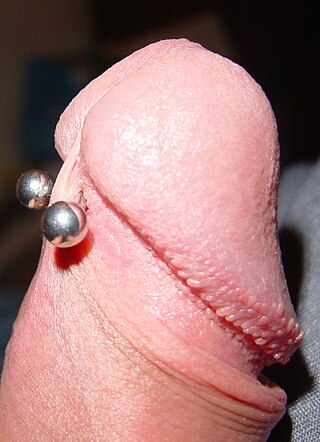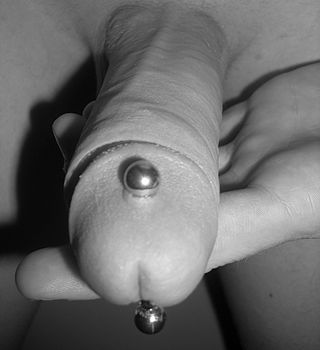


Chastity piercings are types of genital piercings that can be used to impose chastity in males and females. [1] [2] [3] [4]



Chastity piercings are types of genital piercings that can be used to impose chastity in males and females. [1] [2] [3] [4]
A ring or other device is used to hold the labia closed, preventing the wearer from having vaginal sexual intercourse. When denial of direct stimulation of the clitoris is the goal, a rigid shield can be fastened over the clitoral area with labial piercings.
In males, chastity piercing can be performed in several ways. Through infibulation (piercing the foreskin closed), a Prince Albert or frenulum piercing using a smaller gauge locking mechanism (preventing intercourse), or chaining a Prince Albert piercing to a guiche piercing (thus preventing an erection). [ citation needed ] More commonly, a piercing can be used in combination with a chastity device to anchor the penis within the device and prevent it from being pulled out the back. The Prince Albert is the most popular piercing for this purpose.

The Prince Albert (PA) is a penis piercing which extends from the urethra to the underside of the glans. It is one of the most common male genital piercings. The related reverse Prince Albert piercing enters through the urethra and exits through a hole pierced in the top of the glans.

A chastity belt is a locking item of clothing designed to prevent sexual intercourse or masturbation. Such belts were historically designed for women, ostensibly for the purpose of chastity, to protect women from rape, or to dissuade women and their potential sexual partners from sexual temptation. Modern versions of the chastity belt are predominantly, but not exclusively, used in the BDSM community, and chastity belts are now designed for male wearers in addition to female wearers.

A clitoral hood piercing is a female genital piercing through the clitoral hood surrounding the clitoris. In addition to being an adornment, a clitoral hood piercing can enhance sexual pleasure during masturbation, foreplay and intercourse. In an empirical study at the University of South Alabama, the authors reported a positive relationship between vertical clitoral hood piercings and desire, frequency of intercourse, and sexual arousal. There are two main types of clitoral hood piercing: the vertical clitoral hood (VCH) piercing and the horizontal clitoral hood (HCH) piercing. As the names indicate, the difference is in the direction the piercing is oriented in the skin above the clitoris. Neither of these piercings penetrates the clitoris itself, although in common parlance they are sometimes called "clit" piercings. The deep hood piercing is a variation of the clitoral hood piercing that passes deeper through the clitoral hood.

Princess Albertina is a female genital piercing, where a ring enters the urethra and exits through the top of the vagina. Anne Greenblatt described the Princess Albertina to Ralph H. in 1995 as a "relatively new and experimental piercing." Its name comes from the fact that it is analogous to the male Prince Albert piercing.

Sexual stimulation is anything that leads to sexual arousal or orgasm. This thing can be physical or of other senses, and is known as a stimulus.

A frenum piercing is a type of body piercing located on the underside of the shaft of the penis. A series of parallel frenum piercings is known as a frenum ladder. A frenum ladder may be extended to include lorum piercings, hafada piercings and guiche piercings.

The palang or ampallang is a male genital piercing that penetrates horizontally through the entire glans of the penis.

Genital piercing is a form of body piercing that involves piercing a part of the genitalia, thus creating a suitable place for wearing different types of jewellery. Nevertheless, the term may also be used pars pro toto to indicate all body piercings in the area of the anus, perineum, penis, scrotum, and vulva, including piercings such as anal, guiche, and pubic that do not involve perforation of genitalia. Genital piercings can be done regardless of sex, with various forms of piercings available. The main motive is beautification and individualization; in addition, some piercings enhance sexual pleasure by increasing stimulation. Pre-modern genital piercings is most culturally widespread in Southeast Asia, where it has been part of traditional practice since ancient times. Records of genital piercing are found in the Kama Sutra.
Erotic sexual denial is a popular form of sexual activity whereby sexual gratification for one or both partners is delayed or "denied" sexual experiences in order to increase erotic arousal and/or tension. It is commonly used as sex play within the context of a mild dominance and submission relationship, though it can also be a solo practice. When used in the context of dominance and submission, the dominant partner is often encouraged to prioritize their own sexual pleasure over that of their submissive partner. The submissive partner receives gratification from providing sexual pleasure to their partner and from the feelings of vulnerability and tension that come from having their own sexual pleasure controlled by another. The prohibited sexual experience can be narrowly or broadly defined for a specific or indeterminate length of time, depending on the practitioner. The experience withheld can be any favored or desired sexual activities, such as specific acts or positions, provided it is something the practitioner wants.

Cock and ball torture (CBT) is a sexual activity involving the application of pain or constriction to the male genitals. This may involve directly painful activities, such as genital piercing, wax play, genital spanking, squeezing, ball-busting, genital flogging, urethral play, tickle torture, erotic electrostimulation, kneeing, or kicking. The recipient of such activities may receive direct physical pleasure via masochism, emotional pleasure through erotic humiliation, or knowledge that the play is pleasing to a sadistic dominant. Many of these practices carry significant health risks.

A hafada piercing is a surface piercing anywhere on the skin of the scrotum. Piercings on the scrotal raphe or "seam" of the scrotum are common. This piercing does not penetrate deep into the scrotum, and due to the looseness and flexibility of the skin in that area, does not migrate or reject as much as many other surface piercings. The main motives are beautification and individualization. A piercing that passes through the scrotum, from front-to-back, or from side-to-side, is known as a transscrotal piercing. Multiple hafada piercings are not uncommon, often as an extension of a frenum ladder or Jacob's Ladder, which is a series of piercings from the frenulum to the scrotum.

This glossary of BDSM defines terms commonly used in the BDSM community.

A guiche piercing is a body piercing through the perineum. Guiche piercings are much more common in men than in women. Although a guiche normally runs perpendicular to the direction of the penis, lateral placements are possible. A series of guiche piercings in parallel to the direction of the penis is called a guiche ladder, and might commonly be seen as an extension of a frenum ladder.

Chastity belts are a type of chastity device used in BDSM as part of the practice of orgasm denial, to prevent the wearer from engaging in certain types of sexual activity without the permission of the dominant, who acts as the "keyholder", possessing the key that unlocks the chastity belt. Without access to the key, the wearer usually cannot take off the chastity belt or device. Dominants may also enjoy long-distance chastity with their sub by keeping the key in a third location that the chastity wearer cannot access by themself.

Labia piercings are a type of female genital piercing. This piercing can be placed either through the labia minora or the labia majora. They are one of the simpler and more common genital piercings performed on vulvas, and are often pierced in symmetrical pairs. Like all genital piercings, depending on jewellery and placement, they may provide additional stimulation to one or both partners during sexual intercourse.

Non-penetrative sex or outercourse is sexual activity that usually does not include sexual penetration, but some forms, particularly when termed outercourse, include penetrative aspects, that may result from forms of fingering or oral sex. It generally excludes the penetrative aspects of vaginal, anal, or oral sex, but includes various forms of sexual and non-sexual activity, such as frottage, manual sex, mutual masturbation, kissing, or hugging.

Breast torture is a BDSM activity in which sexual stimulation is provided through the intentional application of physical pain or constriction to the breasts, areolae or nipples of a submissive. It is a popular activity among the kink community. The recipient of such activities may wish to receive them as a result of masochism or they may have a desire to please a dominant who is sadistic. Those involved may also be motivated by breast fetishism. Mild breast torture such as light impact play on the breasts is also occasionally used outside of the BDSM context to provide stimulation and pleasure during conventional sex.

Human female sexuality encompasses a broad range of behaviors and processes, including female sexual identity and sexual behavior, the physiological, psychological, social, cultural, political, and spiritual or religious aspects of sexual activity. Various aspects and dimensions of female sexuality, as a part of human sexuality, have also been addressed by principles of ethics, morality, and theology. In almost any historical era and culture, the arts, including literary and visual arts, as well as popular culture, present a substantial portion of a given society's views on human sexuality, which includes both implicit (covert) and explicit (overt) aspects and manifestations of feminine sexuality and behavior.

A body piercing, which is a form of body modification, is the practice of puncturing or cutting a part of the human body, creating an opening in which jewelry may be worn, or where an implant could be inserted. The word piercing can refer to the act or practice of body piercing, or to an opening in the body created by this act or practice. It can also, by metonymy, refer to the resulting decoration, or to the decorative jewelry used. Piercing implants alter the body and/or skin profile and appearance.

The apadravya, like the ampallang, is a genital piercing that passes through the glans. While the ampallang passes horizontally through the glans, the apadravya passes vertically through the glans from top to bottom, almost always placed centrally and passing through the urethra. It can be paired with an ampallang to form the magic cross. Off-center apadravyas are also possible, wherein the piercing is deliberately offset, yet usually still passes through the urethra. The piercing is often done on a slightly forward angle to the hips.